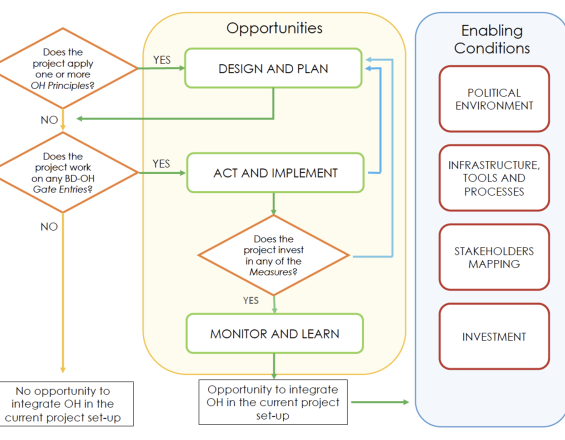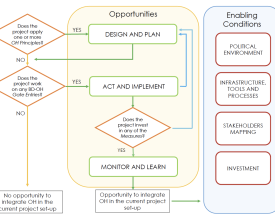
Un marco de análisis para que los proyectos de biodiversidad adopten el enfoque "Una sola salud

El Grupo de Trabajo sobre Biodiversidad de la Red Sectorial de Desarrollo Rural y Recursos Naturales Asia-Pacífico (SNRD-AP) de la GIZ encargó un estudio para explorar el nexo entre biodiversidad y salud en la región. La revisión de la bibliografía y las entrevistas a informantes permitieron comprender el impacto de la pérdida de biodiversidad y la degradación de los ecosistemas en la salud humana y animal, y arrojaron luz sobre el valor de la colaboración en el nexo. El discurso dominante ha descuidado durante mucho tiempo el pilar medioambiental de Una Salud (One Health, OH), y se ha prestado poca atención a la biodiversidad en las acciones clásicas de OH que abordan las enfermedades infecciosas emergentes y la resistencia a los antimicrobianos. El nexo entre biodiversidad y salud es esencial para la prevención de pandemias. Así pues, urge explorar cómo podría integrarse Una Salud en la biodiversidad y, viceversa, cómo podría integrarse la biodiversidad en Una Salud para hacer más eficaz la prevención de pandemias. Este estudio se centra en el desarrollo de una herramienta innovadora para orientar una mejor integración de Una Salud en la conservación de la biodiversidad.
Contexto
Défis à relever
La pérdida de biodiversidad en los ecosistemas terrestres se debe a varios factores, como la degradación de los ecosistemas por cambios en el uso del suelo, el cambio climático, las industrias extractivas y la explotación de productos forestales, el comercio y el consumo de fauna salvaje. Estos factores reducen la distancia física entre los seres humanos, sus animales domésticos y las poblaciones de animales salvajes, lo que aumenta el riesgo de propagación de patógenos zoonóticos de los animales a los seres humanos. El Sudeste Asiático es un punto caliente de biodiversidad y una de las regiones de más rápido desarrollo del mundo. La degradación medioambiental hace de la región una zona de riesgo para la propagación de enfermedades zoonóticas. El valor de "Una sola salud" para abordar estos problemas es bien reconocido. Sin embargo, no existe un camino claro para los proyectos de biodiversidad sobre cómo reconocer las contribuciones a los resultados sanitarios e integrar Una Salud en su trabajo. El Marco de Análisis ofrece a los proyectos una herramienta de evaluación uniforme para descubrir puntos fuertes y potenciales y analizar dónde y cómo pueden iniciarse colaboraciones multisectoriales de Una Salud.
Ubicación
Procesar
Resumen del proceso
Los componentes básicos interactúan entre sí para permitir explorar el nexo entre biodiversidad y salud en los proyectos de conservación de la biodiversidad e identificar dónde y cómo pueden iniciarse colaboraciones multisectoriales de Una Salud. La formación de un equipo de revisión multidisciplinar es el primer paso del proceso. Al equipo se le encomendará la responsabilidad de escanear rápidamente el proyecto utilizando el marco de análisis desarrollado a propósito y descrito aquí como Solución para la integración de Una Sola Salud en la biodiversidad. Esto permitirá identificar las entradas que tienen el potencial de vincularse con el enfoque de Una Salud y aprovechar las medidas ya aplicadas para ponerlo efectivamente en práctica. El siguiente paso requiere la exploración de las condiciones favorables que pueden influir en la actualización real de la intervención identificada de Una Sola Salud. Por último, el equipo de revisión guiará un debate multisectorial y transdisciplinar sobre la integración de Una Salud en el proyecto, mediante la participación de todos los propietarios del proyecto (socios institucionales y de desarrollo) y todos los actores afectados por la intervención (responsables políticos, comunidades locales y proveedores de servicios).
Bloques de construcción
FORMAR UN EQUIPO DE REVISIÓN
Una vez formado, un equipo de revisión dirigirá el análisis del proyecto y la posible integración del enfoque "Una sola salud". Es fundamental iniciar un debate intersectorial, identificar oportunidades de colaboración entre las partes interesadas y permitir el diseño conjunto de componentes de Una Salud que se alineen con los objetivos del proyecto y los impulsen hacia un enfoque holístico del nexo entre biodiversidad y salud. El equipo de revisión es multidisciplinar y debe estar formado por todos los propietarios del proyecto, incluidos los socios institucionales y de desarrollo.
Factores facilitadores
- Composición multidisciplinar del equipo de revisión, incluidos expertos de diferentes sectores (por ejemplo, conservación, sanidad animal, salud humana, educación, ciencias sociales).
- Composición transdisciplinar del equipo de revisión, incluidos expertos de diferentes niveles de intervención y con diferentes funciones (por ejemplo, investigadores, responsables políticos, proveedores de servicios, miembros de la comunidad).
Lección aprendida
Los evaluadores externos pueden contribuir en gran medida y ampliar los resultados del análisis del proyecto en el nexo entre biodiversidad y salud. Pueden guiar al equipo del proyecto a través del proceso de análisis aportando una perspectiva fresca e independiente al análisis del proyecto. Los evaluadores externos deben tener algún tipo de experiencia en colaboraciones multisectoriales y "Una Salud" para guiar al equipo de revisión en el análisis del proyecto y la identificación de oportunidades para integrar un enfoque más holístico.
EXPLORACIÓN RÁPIDA DEL PROYECTO
El primer paso del análisis consiste en evaluar si el proyecto aplica uno o varios principios de la salud humana en su ámbito de trabajo. En el marco se utilizan siete principios de la salud humana, adaptados de la bibliografía (multisectorial, transdisciplinar, participación, prevención, descentralización, basado en pruebas y multiescalar). No todos los principios del marco tienen el mismo valor, y el principio multisectorial se considera un componente esencial de la herramienta propuesta. La razón de ello es que la base de "Una sola salud" es la colaboración entre diferentes sectores. El marco permite colaboraciones multisectoriales a cualquier nivel, por ejemplo cuando se ha firmado un memorando de entendimiento entre ministerios, o a nivel comunitario mediante el esfuerzo conjunto de los trabajadores sanitarios de las aldeas, los voluntarios de sanidad animal y los guardas forestales.
Factores facilitadores
- Consulte las definiciones de cada principio para comprender correctamente su significado en relación con el marco de análisis.
- Examine el proyecto simplemente buscando la mera aplicación de los principios y evite sacar conclusiones precipitadas sobre la adopción del enfoque "Una sola salud".
Lección aprendida
Un rápido examen del proyecto permite conocer su estado actual. Si el proyecto ya aplica uno o más principios de Una Salud, existen oportunidades inmediatas para diseñar y planificar un componente de Una Salud dentro de su ámbito de trabajo. Sin embargo, el hecho de que no se aplique ni siquiera un solo principio no impide que se aplique el enfoque "Una sola salud", ni implica que el análisis del marco tenga que detenerse. El análisis rápido del proyecto ayudará a aclarar qué principios deben explorarse e incluirse para aplicar con éxito el enfoque "Una sola salud".
IDENTIFICAR LAS ENTRADAS
Las entradas Gate son áreas temáticas en las que el proyecto lleva a cabo actividades o acciones que tienen el potencial de vincularse a un enfoque de Una Salud. Representan oportunidades reales de integrar y transformar los objetivos del proyecto y los de Una Salud en un objetivo común. En el nexo entre biodiversidad y salud, el marco identifica cinco entradas principales clave: Enfermedades Infecciosas Emergentes y Zoonosis, Producción Agrícola y Seguridad Alimentaria, Cambio Climático y Reducción de Riesgos, Comercio y Consumo de Fauna Silvestre, y Conservación de la Biodiversidad (incluyendo Soluciones Basadas en la Naturaleza, Áreas Protegidas y Gestión de la Fauna Silvestre).
Factores facilitadores
- Consulte las definiciones de las entradas para asegurarse de que comprende correctamente su significado en relación con el marco de análisis.
Lección aprendida
Puede haber más de una puerta de entrada al nexo entre biodiversidad y salud en el mismo proyecto. Sin embargo, se recomienda centrarse sólo en una puerta de entrada para iniciar la integración del enfoque de la OH. El proceso requiere esfuerzos y recursos para establecer nuevas asociaciones, codiseñar nuevos componentes del proyecto y establecer medidas e infraestructuras que permitan la comunicación, la colaboración, la coordinación y el desarrollo de capacidades entre sectores y disciplinas. Un enfoque limitado puede facilitar el proceso y aumentar la tasa de éxito. Las pruebas generadas en iniciativas a pequeña escala pueden servir para reproducirlas a mayor escala y fundamentar la elaboración de políticas sobre la puesta en práctica de "Una sola salud" en proyectos relacionados con la biodiversidad.
MEDIDAS DE APALANCAMIENTO
Las medidas son intervenciones o actividades que ya se aplican en el proyecto y que pueden permitir la creación de un componente de "Una sola salud" dentro de su ámbito de aplicación. Permiten hacer operativa la integración de "Una sola salud" de forma óptima y pertinente. El marco identifica ocho medidas: educación y sensibilización, desarrollo de políticas, desarrollo de capacidades, plataformas de colaboración, participación comunitaria, intercambio de información, vigilancia y alerta temprana, e investigación.
Factores facilitadores
- Consulte las definiciones de cada medida para comprender correctamente su significado en relación con el marco de análisis.
- Revise el proyecto simplemente buscando las entradas y evite sacar conclusiones precipitadas sobre la adopción del enfoque "Una sola salud".
Lección aprendida
Las medidas propuestas en el marco de análisis son habituales en los proyectos de biodiversidad y conservación. El reto aquí es aprovecharlas para permitir la integración del enfoque "Una sola salud" en el proyecto. La actividad o el componente pueden rediseñarse y planificarse de nuevo trabajando en todos los sectores y añadiendo las perspectivas de diferentes disciplinas y agentes. La medida transformada e integrada aumentará su valor y tendrá mayores repercusiones en el nexo entre biodiversidad y salud.
EXPLORAR LAS CONDICIONES FAVORABLES
Las condiciones favorables determinan el éxito de la integración de la OH en el proyecto. Su cumplimiento es necesario para crear un entorno adecuado para colaboraciones y actividades sostenibles y óptimas. Las condiciones favorables identificadas en el marco incluyen un entorno político propicio que anime a los agentes gubernamentales y no estatales de todos los niveles organizativos pertinentes a colaborar de buen grado; infraestructuras, herramientas y procesos que faciliten el intercambio de datos y permitan el diseño conjunto de intervenciones multisectoriales en la interfaz hombre-animal-medio ambiente; una cartografía detallada de las partes interesadas que permita identificar los puntos fuertes y potenciales de los distintos agentes y promueva el establecimiento de una colaboración valiosa; y una inversión significativa que sostenga la aplicación del enfoque "Una sola salud" en proyectos nuevos o ya existentes.
Factores facilitadores
- Realizar un análisis exhaustivo del contexto político en el país de intervención, para identificar iniciativas gubernamentales y no estatales que apoyen la operacionalización de la OH.
- Analizar las infraestructuras y los activos ya disponibles en el proyecto que puedan facilitar la colaboración y la comunicación con otros sectores e iniciativas.
Lección aprendida
El incumplimiento de las condiciones de habilitación no descalifica automáticamente un proyecto para incluir el enfoque "Una sola salud". Sin embargo, puede dificultar la puesta en práctica real de la integración en el proyecto. Las iniciativas a pequeña escala que requieren una inversión limitada pueden representar una opción viable para poner a prueba la integración de Una Salud en el nexo entre biodiversidad y salud, incluso cuando no se cumplan todas las condiciones favorables. Las iniciativas contribuirán a la generación de pruebas y respaldarán los argumentos a favor de "Una sola salud" entre los responsables políticos y los inversores, lo que a la larga impulsará las condiciones propicias para futuras intervenciones.
DISCUTIR LA INTEGRACIÓN DE OH
La adopción del enfoque "Una sola salud" en los proyectos relacionados con la biodiversidad requiere un debate abierto y participativo entre todos los agentes y partes interesadas implicados y afectados por el propio proyecto. El debate se basará en los resultados del análisis del proyecto, planificando de forma colaborativa cómo(principios) y dónde(entradas) puede aplicarse el enfoque "Una sola salud" e identificando qué(medidas) puede hacerse para garantizar que la integración sea óptima y pertinente. El equipo de revisión dirigirá la preparación de un plan de acción que garantice el cumplimiento de los factores fundamentales(condiciones favorables) y oriente la puesta en práctica del componente "Una sola salud" en la interfaz ser humano-animal-entorno.
Factores facilitadores
- Involucrar en el debate a un amplio espectro de actores y partes interesadas, garantizando la representación de los diferentes sectores y grupos afectados por el proyecto.
- Promover un diálogo abierto entre todos los actores, para fomentar el intercambio y la integración entre el conocimiento científico y el tradicional
Lección aprendida
La integración de "Una sola salud" en los proyectos relacionados con la biodiversidad puede ser un proceso complejo. Tres estrategias pueden facilitar la tarea y ayudar al equipo de revisión a alcanzar el objetivo. La aclaración de la definición de "Una sola salud" en el contexto del proyecto específico para garantizar que todos los actores comparten la misma comprensión del enfoque y el valor de su integración en el proyecto. La identificación de un ámbito limitado para la adopción del enfoque de Una Sola Salud dentro del proyecto, con el fin de poner a prueba la capacidad del equipo para establecer nuevas asociaciones, trabajar entre disciplinas y crear iniciativas que difieran de su actividad habitual. La contratación de asesores externos, expertos en la puesta en práctica de "Una sola salud", para ayudar al equipo en el proceso colaborativo de identificación de oportunidades de colaboración en el nexo entre biodiversidad y salud.
Impactos
El marco de análisis se elaboró para ayudar al Grupo de Trabajo sobre Biodiversidad del SNRD-AP a aplicar el enfoque de Una Sola Salud en los proyectos relacionados con la biodiversidad en la región del Sudeste Asiático. El marco permite evaluar si el proyecto tiene una base suficiente para Una Salud y si ya aplica los principios clave de la salud humana. Permite identificar las posibles entradas en las que puede integrarse un elemento de "Una sola salud" y evaluar las medidas que podrían permitir incorporar un elemento de "Una sola salud" al proyecto. Mediante la aplicación del marco, los propietarios y las partes interesadas son guiados en la revisión del proyecto adoptando el prisma de la salud humana, identificando nuevas oportunidades para trabajar entre disciplinas e implicando a nuevos actores. El marco debe considerarse un punto de partida para el proceso transformador de incorporar Una Salud a la biodiversidad. Es necesario un cambio radical de mentalidad para desglosar el proceso de aplicación del enfoque de Una Salud en medidas manejables y factibles que sean específicas para cada contexto y proyecto. Al hacerlo, es probable que las acciones y los éxitos a pequeña escala aumenten la confianza en el proceso y allanen el camino para una integración más amplia de Una Salud dentro de la comunidad conservacionista. El marco de análisis se puso a prueba en seis proyectos para verificar su validez. El grupo de trabajo Biodiversidad-Una Salud del Grupo de Trabajo sobre Biodiversidad del SNRD-AP recibió formación sobre el proceso paso a paso para garantizar su aplicación a mayor escala.
Beneficiarios
Los beneficiarios del marco son los equipos de los proyectos relacionados con la biodiversidad dentro del Grupo de Trabajo sobre Biodiversidad del SNRD-AP. A mayor escala, la herramienta beneficiará a socios y partes interesadas que aprenderán a integrar Una Salud en su trabajo.


